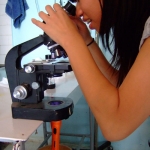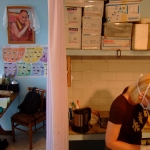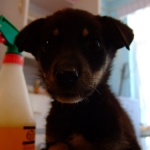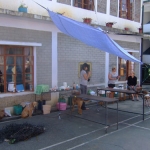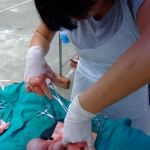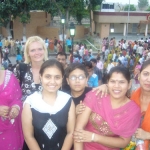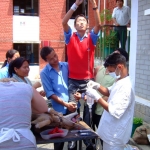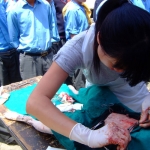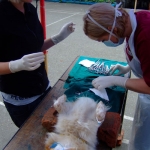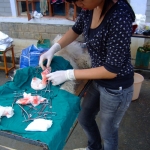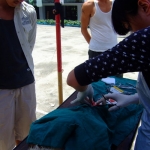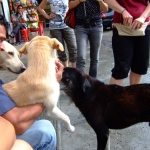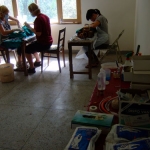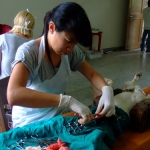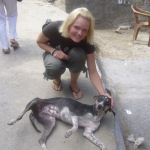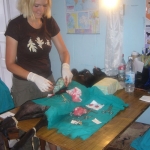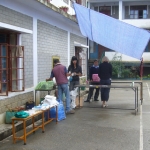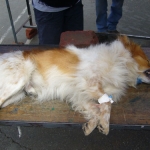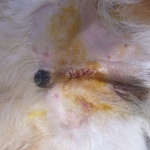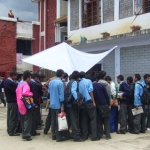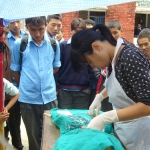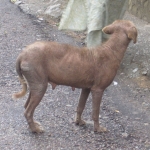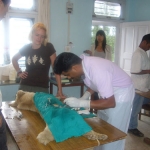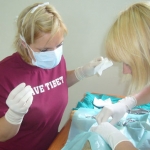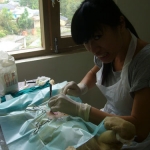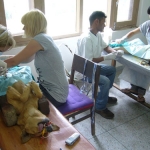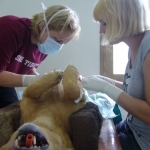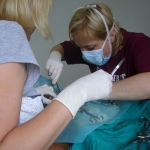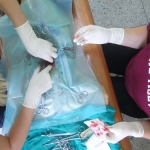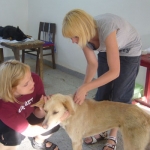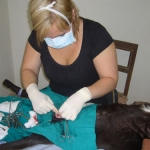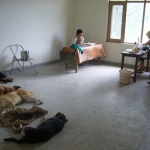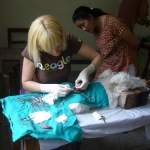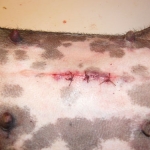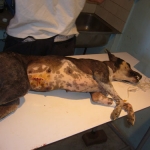Af Mark Kim, Vet.
Drs Sonya Yu and I joined final year students from Denmark, Maria and Louise, in New Delhi to head up to McLeod Ganj for 3 weeks of volunteer work with Tibet Charity. Sonya and I had never been to India before, and the thrill of Delhi was in stark contrast to the incredible scenery of the Himalayas that greeted us on arrival.
After settling into our accommodation at a neighbouring guest house, we had a patient waiting for us even before we’d had any chance to settle into the clinic at Tibet Charity (T.C.) House. Getting straight into the work was the perfect way to settle our minds with something more familiar after 3 days of cultural revelations. Even after half a day in the clinic and the upstairs classrooms, we got a sense of the very relaxed, very welcoming atmosphere that we thoroughly enjoyed for the whole 3 weeks. The first people we met were 2 volunteer English teachers, Shaun and Tanya, an American couple who were coming to the end of their stay.
In the clinic, we were finally introduced to Bishan Das, or Vishnu, the vet nurse already held in high esteem from Louise’s experience of the previous year. Many other people entered our circle of companions over the next few days, from Bhum the general fixer-of-everything, to Rinzin, the lovely Tibetan English teacher, and of course, the Director, Tsering Thundup. Our clinic was a smallish, but well setup room with the most efficient use of space as one would ever find in any clinic, anywhere in the world. And this was where we began with a street dog with mange. Mange, as we learnt very quickly, was an extremely common affliction in street dogs, as frequent preventative treatments was near impossible to carry out.
The work in Himachal Pradesh involved 3 main components: local work in Dharamsala neutering street dogs and treating any diseases/injuries of dogs caught or brought in by concerned locals; setting up neutering camps in regional towns, again also treating any medical conditions; and finally the rabies vaccination program carried out everywhere we went.
The latter probably carried the least significance for us personally prior to our time there, but for reasons described below, was eventually realised for its true value in controlling the disease. Our first camp was at a satellite school of the main TCV School in Suja. Over the next couple of days, we had an excellent time staying on school grounds, and during the day, operating on local strays caught for us by the students. There were many unforgettable scenes of Tibetan high school students crowding around our makeshift surgery tables set up under the open skies (with tarpaulin sheet prepared in case of rain) in the courtyard of one of the student dormitories. One thing we found time and again here and in some of the places in and around Dharamsala, but perhaps less so in the bigger cities of India, was the excellent condition many of the stray dogs were in, being looked after so well by the animal loving local (Buddhist) population.
As with many of our camps and road trips, there was a visit to one of the nearby monasteries, where we also attempted to find some surgical equipment left there the previous year! From Suja, we drove to Tashi Jong, another beautiful Buddhist monastery, for another couple of days of surgery. Here, we were hosted on the first night by the head monk, the Rinpoche, and one of the senior Korean nuns. Like everywhere else, we could see evidence of previous camps, with numerous dogs carrying the distinct ear notch, as proudly pointed out by Vishnu. After 2 days, we had neutered over 15 dogs, and treated many for mange, as well as vaccinating many more. Again, there was a very friendly attitude from the locals, who openly showed their appreciation of our work, and as we left, we were to humbly accept several Buddhist shawls from the residents. After nearly a week away, we very much looked forward getting back to our new “home”. We spent a couple of days unwinding, during which Vishnu took us up for an inspiring ascent into the surrounding mountains, followed by a gruelling descent, as our fitness failed us dismally, while Vishnu and his wife effortlessly cruised ahead.
Shortly after this, we were to experience first hand the horrors of the disease we were here working against. One of the TC staff was bitten by a stray dog, whom we later confirmed on suspicion as being rabid. Reports followed later in the day, while we attempted to get the human immunoglobulins for the staff member, that several other people and dogs had been bitten. This set the scene for the next week or so as we attempted to catch the rabid dog and begin inoculating as many of the local strays as possible. For the first time during our trip, there was an element of seriousness and heaviness in the air as we thought about the immediate and long term repercussions of what had happened.
It was like nothing we had experienced before, and put into perspective our fortunate position in life, since once we had left India, we were no longer living with this threat that locals lived with everyday and with complete acceptance. It also brought about many interesting discussions among us in regards to protocols for such situations. Factors to be considered were: – extent of our involvement as a charity organisation operating under strict regulations of local authorities; – the effort (or lack thereof) of local authorities in catching dogs suspected of having rabies, and the manner in which this is carried out; – dealing with animals suspected of being bitten- there were several different thoughts from various persons involved, from local vets to foreign vets to medical texts and resources; – educating locals on the whole rabies disease process; and – taking into account the very important issue of Buddhist philosophy on matters of euthanasia. Ultimately, we did not progress far beyond dealing with the immediate situation only.
There are several similar programs being carried out around the world, some with many more years experience. Even still, there are no protocols set in concrete, and as we found, it is the immediate situation that is most important to be attended to with the short time available. Together with the plans for long term practice of TC, this will hopefully create an ‘ecosystem’ amongst the stray dog population in India, which seems part and parcel of daily life, that will minimise the propagation of rabies. And the long term future of organisations such as TC require the continual supply of volunteers from the developed world, something we aim to contribute to for many years to come.
Mark Kim, Vet.[divider]

